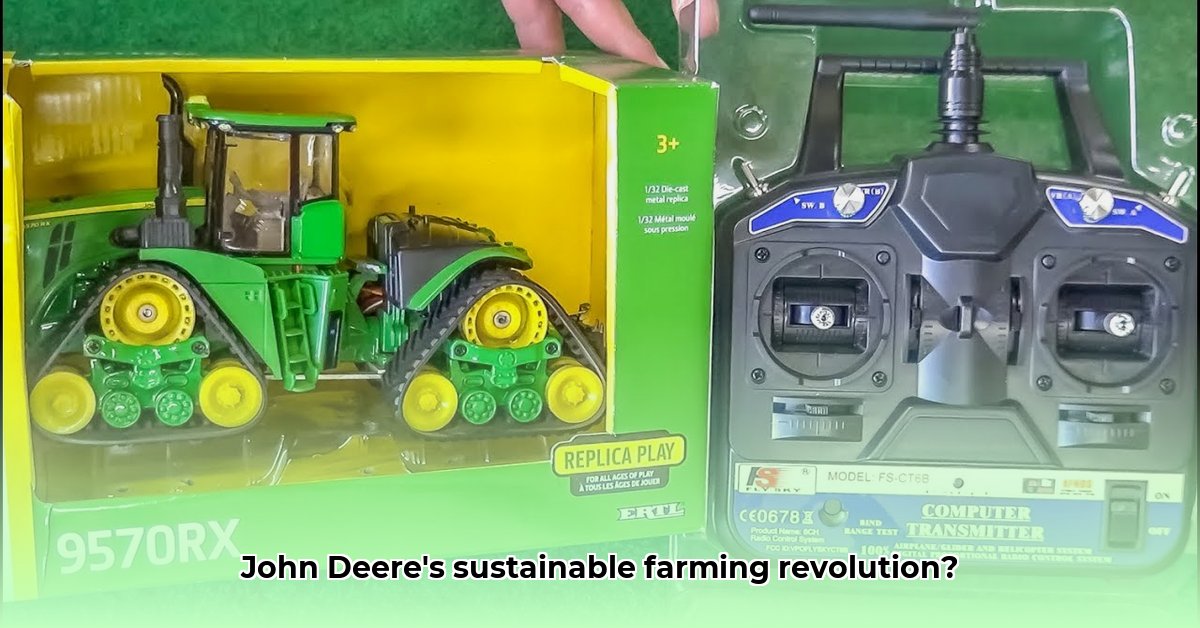
The agricultural landscape is undergoing a dramatic transformation, fueled by technological advancements. Among the most promising innovations is the rise of remote-controlled (RC) tractors, with John Deere leading the way. These aren't your grandfather's tractors; they represent a sophisticated blend of GPS technology, automation, and data analysis, promising a future of increased efficiency and environmental sustainability. But how realistic is this vision, and what are the challenges and opportunities that lie ahead? For more on older models, see this John Deere Tractor history.
How the RC John Deere Tractor Revolutionizes Farming
Imagine guiding a powerful tractor across your fields from the comfort of your office, hundreds of miles away. This isn't science fiction; it's the reality offered by the RC John Deere tractor. Utilizing highly accurate GPS technology (think satellite navigation precise to within inches), the tractor precisely navigates its environment. A comprehensive network of sensors constantly monitors various parameters, from soil conditions and speed to fuel levels and more. This data streams to a tablet or computer, providing the operator with complete oversight and control.
This precision isn't merely a matter of convenience; it's the key to unlocking significant efficiency gains. Automated systems allow for incredibly accurate planting, tilling, and harvesting. This translates to less wasted seed, fertilizer, and water—a win-win for both the farmer’s bottom line and the environment. The ability to operate around the clock, irrespective of weather or daylight limitations, has the potential to significantly boost yields. It's like having a tireless, expert farmhand working 24/7. But how does this impact the bottom line? Is the investment worth the cost savings and boosted yields? Only a thorough cost-benefit analysis can answer this crucial question for small farms.
The Challenges and Opportunities in the Field
While the promise of remote-controlled farming is alluring, the path to widespread adoption isn't without challenges. A primary obstacle is the high upfront cost. These tractors represent a significant investment, potentially posing a major hurdle for smaller farming operations. Cybersecurity is another critical area of concern. What happens if a hacker gains unauthorized control? Robust, fail-safe security measures are essential for mitigating this risk. Similarly, maintaining reliable internet connectivity is paramount; a disruption could halt crucial operations midway, leading to potential crop damage and financial losses.
Despite these obstacles, the potential benefits for large operations are considerable. Consider the potential savings in labor costs, the increase in yields due to precision farming, and the positive environmental impact. To unlock the technology's full potential, the industry must focus on making RC tractors more readily accessible and affordable across the spectrum of farm sizes, from large corporations to small family-run businesses. The opportunities are vast, but the path requires careful and collaborative navigation.
Sustainability: Separating Fact from Fiction
The RC John Deere tractor is frequently marketed as a pillar of sustainable agriculture. While alluring, this claim requires more rigorous investigation. While reduced fuel consumption, due to optimized operational efficiency, is a clear advantage, a comprehensive assessment of the overall environmental impact is needed. This includes a thorough analysis of the carbon footprint associated with manufacturing, operation, and disposal of the machines. Independent studies are necessary to evaluate the long-term effects on the ecosystem. While the potential benefits are significant, definitive conclusions remain premature until such studies are available and reviewed.
The Future Landscape of Farming: A Look Ahead
The RC John Deere tractor signals a significant leap forward for agriculture, pointing towards a smarter, more efficient, and potentially more sustainable future. However, several key factors influence the speed and breadth of technology adoption. Affordability is paramount. Advanced cybersecurity measures are critical to ensure reliability and confidence in the technology. The technology must continue to adapt to the diverse requirements of farms and varied crops.
This journey towards widespread adoption isn't a solo venture. It requires a collaborative effort involving manufacturers focusing on affordability and security enhancement; farmers requiring sufficient training and effective support; and policymakers establishing a supportive regulatory environment. The future of sustainable agriculture hinges on how effectively we address these challenges and embrace this technological leap.
Comparing Traditional and RC John Deere Tractors: A Side-by-Side Look
| Feature | Conventional Tractor | RC John Deere Tractor |
|---|---|---|
| Labor Costs | Higher | Potentially significantly lower |
| Precision | Lower | Much higher |
| Fuel Efficiency | Varies depending on usage | Potentially higher, but needs study |
| Initial Investment | Lower | Significantly higher |
| Environmental Impact | Potentially higher | Potentially lower, requires research |
| Operational Flexibility | Limited by daylight and weather | 24/7 operation, regardless of weather |
| Data Collection & Analysis | Minimal | Comprehensive data collection and analysis |
This comparison highlights the key distinctions between traditional and remote-controlled tractors. Farmers must carefully consider these trade-offs in determining the suitability of this technology for their operation.
How to Compare Costs of Remote Controlled vs Traditional Tractors for Small Farms
The decision of whether to invest in an RC tractor, especially for small farms, demands a meticulous cost-benefit analysis. The high initial investment is a considerable hurdle. However, potential long-term cost savings from reduced labor and fuel consumption must be considered.
Key Cost Factors:
- Purchase Price: RC tractors command a significantly higher initial cost.
- Operating Costs: While maintenance is necessary, automation may reduce fuel usage.
- Labor Costs: This is where substantial long-term savings may be realized. RC tractors can operate constantly, minimizing labor needs.
- Repair and Maintenance: More advanced technology may result in pricier repairs and specialized technicians.
- Infrastructure: A robust cellular or satellite connection is vital for RC tractors.
- Software and Data: Ongoing subscription fees for software access and data are common.
A comprehensive comparison of these costs, tailored to each farm's specific needs and circumstances, is essential prior to committing to an RC tractor. FlareCompare provides a valuable resource for this assessment.